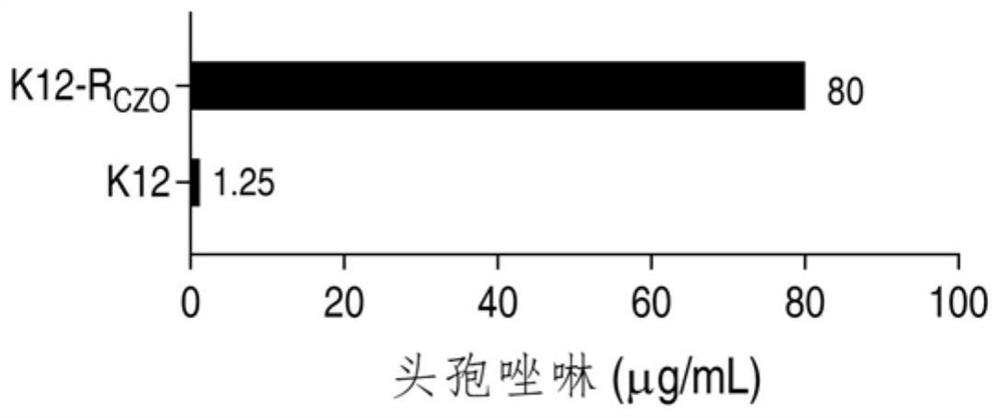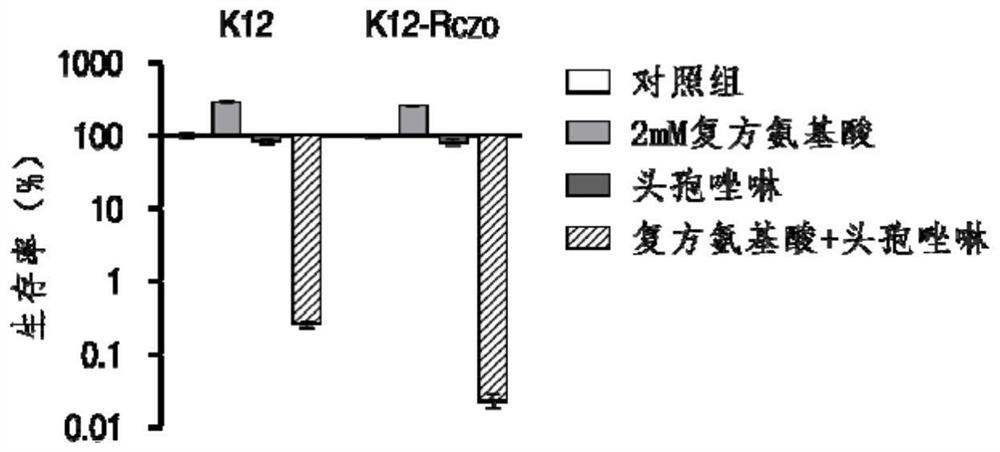Application of compound amino acid in preparation of medicine for improving sensitivity of bacteria to antibiotics
A compound amino acid and antibiotic technology, applied in the field of biomedicine, can solve the problems of unsatisfactory bacterial effect and limited effect, and achieve the effects of less adverse reactions, low nitrogen content and high purity
- Summary
- Abstract
- Description
- Claims
- Application Information
AI Technical Summary
Problems solved by technology
Method used
Image
Examples
Embodiment 1
[0045] Embodiment 1 compound amino acid improves the sensitivity of cefazolin Escherichia coli drug-resistant bacteria to cefazolin
[0046] 1.1 Artificial passage of drug-resistant bacteria-cefazolin Escherichia coli-resistant bacteria
[0047]Taking Escherichia coli K12 as the starting strain, it was continuously passaged in the cefazolin liquid medium containing 1 / 2 minimum inhibitory concentration (MIC), and streaked on the plate every five generations to obtain single clones and determine their The MIC of cefazolin; until the MIC of the obtained strain is 80 μg / mL, which is 64 times that of the starting strain (for details, see figure 1 ), named as cefazolin-resistant Escherichia coli (K12-R CZO ).
[0048] 1.2 Compound amino acids improve the sensitivity of Escherichia coli and cefazolin-resistant Escherichia coli to cefazolin
[0049] Experimental materials: three compound amino acids with a total amino acid content of 5%, 8.5%, and 11.4%, respectively. The molar con...
Embodiment 2
[0076] Example 2 Compound amino acids improve the sensitivity of bacteria to antibiotics and have antibiotic specificity
[0077] 2.1 Significantly improve the bactericidal efficiency of cephalosporin antibiotics
[0078] It was further studied that after adding 0.125, 0.5, 2.0, 8.0, 32, 64 mM compound amino acids, cephalosporin antibiotics (10 μg / mL ceftriaxone, 200 μg / mL ceftiofur) acted on Escherichia coli K12 for 6 hours, and the bacterial survival rate impact; results see Figure 8 .
[0079] It can be seen from the figure that after 0.125, 0.5, 2.0, 8.0, 32, 64 mM compound amino acids synergized with ceftriaxone, the bacterial survival rates were 73.1%, 54.3%, 13.5%, 0.115%, 0.00827%, 0.00345% and 0.00173%. K12 The survival rate decreased by 1.35 times to 42352 times; after synergy with ceftiofur, the bacterial survival rate was 61.9%, 77.7%, 20.7%, 0.00907%, 0.00589%, 0.00213% and 0.000711%, and the survival rate of the sensitive bacteria K12 decreased by the fold. U...
Embodiment 3
[0089] Example 3 The effect of compound amino acids in synergy with cefazolin on the survival rate of other species of bacteria
[0090] Select other gram-negative bacteria such as Vibrio alginolyticus, Vibrio parahaemolyticus, Pseudomonas aeruginosa, and gram-positive bacteria Bacillus subtilis as the research objects to investigate the bactericidal effect of compound amino acids in synergy with cefazolin; Among them, the compound amino acid concentration was 2mM, cefazolin was 80μg / mL, and the relative survival rate of bacteria was calculated after incubation for 6h; the results are shown in Figure 12 .
[0091] It can be seen from the figure that after the addition of 2 mM compound amino acids, cefazolin reduced the survival rate of Vibrio alginolyticus from 62.1% to 13.9%, and the synergy factor was 4.5 times ( Figure 12 A); led to the reduction of the survival rate of Vibrio parahaemolyticus from 79.3% to 1.54%, and the synergy factor was 51.6 times ( Figure 12 B); l...
PUM
 Login to View More
Login to View More Abstract
Description
Claims
Application Information
 Login to View More
Login to View More - R&D
- Intellectual Property
- Life Sciences
- Materials
- Tech Scout
- Unparalleled Data Quality
- Higher Quality Content
- 60% Fewer Hallucinations
Browse by: Latest US Patents, China's latest patents, Technical Efficacy Thesaurus, Application Domain, Technology Topic, Popular Technical Reports.
© 2025 PatSnap. All rights reserved.Legal|Privacy policy|Modern Slavery Act Transparency Statement|Sitemap|About US| Contact US: help@patsnap.com



